|
|
|
Sort Order |
|
|
|
Items / Page
|
|
|
|
|
|
|
| Srl | Item |
| 1 |
ID:
189072
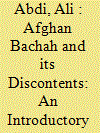

|
|
|
|
|
| Summary/Abstract |
Afghanistan is one of the few places where the category of bachah—the beardless young male—has maintained its aesthetic and erotic aspects in the public imagination. This article provides an introduction to the history of the various arrangements of man-bachah relationships in Afghanistan from the rise of the Afghan kingdom in the late eighteenth century. By looking at both primary and secondary sources, alongside ethnographic materials gathered during fieldwork in Afghanistan between 2016 and 2021, this article shows how the content and implications of the category of bachah have been in constant flux and intimately connected to wider social, political, and economic developments both inside the country and beyond.
|
|
|
|
|
|
|
|
|
|
|
|
|
|
|
|
| 2 |
ID:
189067
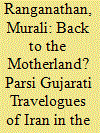

|
|
|
|
|
| Summary/Abstract |
The publication of four Gujarati travelogues written by Parsis traveling to Iran in quick succession in the 1920s marked the intensification of a relationship that had hitherto been based mainly on philanthropy directed towards the Zoroastrians of Iran. The Pahlavi regime, with its assurances of religious tolerance and equity, prompted Parsis to consider deepening their connection with Iran through trade and business investments and also examine the possibility of return to their motherland. The encounters which constitute these travelogues could be framed as experiments which helped the Parsi community in India to construct a framework for developing this relationship. The Parsi travelogues, while attempting to recover a Zoroastrian past in Iran, also try to map the future for the community by addressing its present anxieties and aspirations.
|
|
|
|
|
|
|
|
|
|
|
|
|
|
|
|
| 3 |
ID:
189071


|
|
|
|
|
| Summary/Abstract |
This paper aims to investigate the usage and frequency of what we refer to as K-suffixes in Classical New Persian of the ninth to thirteenth centuries, Contemporary Written Persian of the late nineteenth to mid-twentieth centuries, and Contemporary Spoken Persian. It shows that K-suffixes are most likely to be the reflexes of earlier evaluative morphemes, traditionally called “diminutives,” and are characterized by a high degree of multifunctionality. While evaluative functions continue to dominate in the Classical New Persian works, they have largely been lost in contemporary spoken Persian, and the suffix is now systematically used to express definiteness. The development of the K-suffix as a definiteness marker in contemporary colloquial Persian appears to be innovative, and is mainly dependent on genre, speaker, and speech situation.
|
|
|
|
|
|
|
|
|
|
|
|
|
|
|
|
| 4 |
ID:
189069
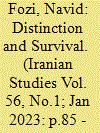

|
|
|
|
|
| Summary/Abstract |
This article argues that the notion of Iranian culture employed in the public discourse of Zoroastrians allows them to tackle the dilemma of Shiʿi-dominated Iranianness without provoking Shiʿi authorities. The piece offers an analysis of ethnographic data, including detailed speech acts documented in Zoroastrians’ ritual spaces and cultural exhibitions. It explores the Zoroastrian configuration of an Iranian culture that summons and encodes pre-Islamic tropes and modern nationalist sentiments by constantly maneuvering around national, religious, and ethnic categories. This configuration's underpinning assumptions, narratives, and texts have powerful platforms in Iranian nationalist imagination. I propose that this arrangement attempts to carve out a space for Zoroastrians’ distinct identity by connecting the history of the Muslim Arab invasion of Persia to the Shiʿi hegemonic norms of Iranian culture today. It further invokes Zoroaster's indigeneity and teachings as the foundation of authentic Iranianness to establish Zoroastrians’ survival as a cultural system.
|
|
|
|
|
|
|
|
|
|
|
|
|
|
|
|
| 5 |
ID:
189073


|
|
|
|
|
| Summary/Abstract |
Poetry readings are an intimate affair; they are not suitable for mobilizing the masses. But poems can capture moods and trigger emotions. They can create closeness and community, send messages and demand change. Indeed, in the case of Iran, a series of poetry reading sessions can be considered a milestone event on the country's path toward revolution.2 During ten nights of poetry reading, known as the dah shab, in October 1977 in Tehran, the country's most prominent poets and writers took advantage of a short window of opportunity that opened up for them when the Shah loosened somewhat the reins of dictatorship. Beginning on October 10, 1977, they presented their poems to thousands of listeners on ten consecutive evenings on the premises of the German-Iranian Cultural Association on Pahlavī Avenue. Poets of all political persuasions were present, united above all in their common interest of demanding an end to censorship and standing up for freedom of speech. The impressive list of participants includes such well-known names as Behazin, Simin Behbehani, Mehdi Akhavan-Sales, Houshang Golshiri, Saeed Soltanpour, and Siavosh Kasrai, along with many more.
|
|
|
|
|
|
|
|
|
|
|
|
|
|
|
|
| 6 |
ID:
189068
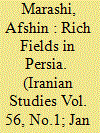

|
|
|
|
|
| Summary/Abstract |
This article investigates the history of economic relations between Iran and the Parsi community of India during the Reza Shah period. Encouraged by the policies of the new Pahlavi state, Parsi entrepreneurs began a serious effort to investigate the possibilities of economic investment in Iran. The article details three Parsi economic missions that were conducted in Iran during this period, and analyzes their assessments of Iran's potential for development in fields such as energy, textile manufacturing, commercial agriculture, and modern transportation systems. As the article argues, while these Parsi-led initiatives were part of a larger history of renewed engagement between Parsis and Iranians, for a variety of political and economic reasons, by the outbreak of World War II few of the Parsi plans for investment in Iran had come to fruition. While remaining largely forestalled in the interwar period, the article also suggests that Parsi economic assessments foreshadowed many of the planning strategies carried out in Iran's post–World War II history of economic development.
|
|
|
|
|
|
|
|
|
|
|
|
|
|
|
|
| 7 |
ID:
189070
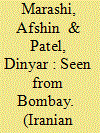

|
|
|
|
|
| Summary/Abstract |
This photo essay provides a visual archive of Parsi philanthropic efforts toward the Iranian Zoroastrian communities of Yazd, Kerman, and Tehran during the 1930s. The essay reproduces a collection of photographs from a photo album produced by the Iranian Zoroastrian Anjoman (est. 1918) for the benefit of Parsi audiences in Bombay. These photographs were taken and compiled by administrators of the Parsi-funded charities in order to demonstrate to Bombay-based Parsi benefactors how their charity efforts were being used inside Iran. The essay also discusses the importance of including visual archival material as part of the social and cultural history of modern Iran, as well as the unique sets of challenges that such archival preservation represents.
|
|
|
|
|
|
|
|
|
|
|
|
|
|
|
|
| 8 |
ID:
189066


|
|
|
|
|
| Summary/Abstract |
A hundred years ago in colonial Bombay, on September 10, 1922, a group of Parsis established an organization called the Iran League. Meant to strengthen ties with their Iranian Zoroastrian coreligionists inside Iran, the Iran League also endeavored to recast wider economic and cultural relations between India and the country which Parsis regarded as their ancient homeland. That ancient homeland, after all, was undergoing seismic change. In the years following Reza Khan's 1921 coup and the establishment of the Pahlavi dynasty in 1925, Parsis watched with growing anticipation and excitement as Iran's new leader increasingly promoted a new national culture rooted in Iran's ancient past. Prominent Parsis, many of them leaders in the Iran League, fervently believed that Pahlavi Iran would herald all sorts of progressive change: improved conditions for the Iranian Zoroastrians, deeper appreciation of Zoroastrianism among Iran's Muslim majority, conditions for significant Parsi investment in Iran, and even the possibility of a mass Parsi “return” to the shah's domain, reversing the direction of centuries of Zoroastrian migration.
|
|
|
|
|
|
|
|
|
|
|
|
|
|
|
|
|
|
|
|
|